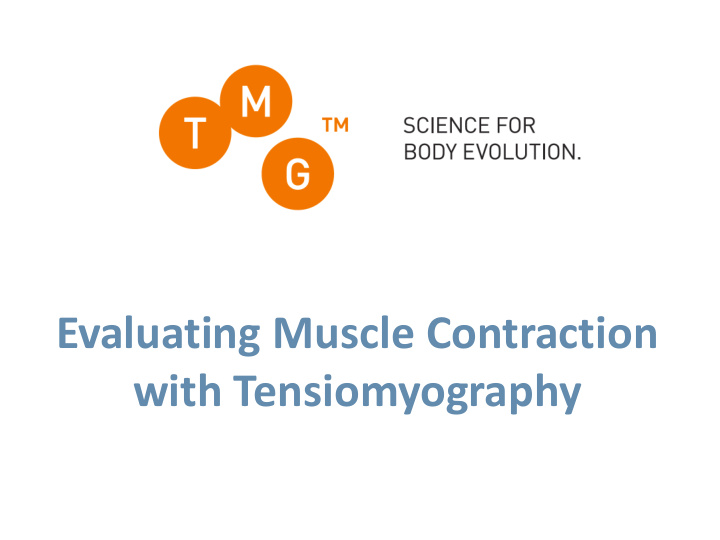



Evaluating Muscle Contraction with Tensiomyography
What is Tensiomyography? Diagnostic method Contractile properties Superficial skeletal muscle
Application areas Sport – Performance, Injury prevention Medicine – Rehabilitation monitoring Research – Scientific publications
Tensiomyography
Tensiomyography
TMG Parameters Td - Delay time 10 Tc - Contraction time Tc Tr Ts - Sustain time 9 Tr - Relaxation time 8 Dm - Displacement 7 Displacement (mm) 6 Ts 5 Dm 4 3 2 Td 1 0 0 50 100 150 200 250 300 350 400 450 500 Time (ms)
Muscle Response Scenarios
Sensitivity: raw data signals Dm healthy: 4,3mm Dm injured 1: 2,6mm Dm injured 2: 9,0mm 10 9 Tc healthy: 20,33ms 8 Tc injured 1: 26,85ms Tc injured 2: 31,27ms Healthy 7 Injured 1 6 Injured 2 5 4 3 2 1 0 1 15 29 43 57 71 85 99 113 127 141 155 169 183 197 211 225 239 253 267 281 295 309 323 337 351 365 379 393 407 421 435 449 463 477 -1
Reference database Male
Basic Results
Lateral and Functional Symmetry • Lateral Symmetry • Functional Symmetry - Antagonistic Pairs • Functional Symmetry - Synergistic Pairs
Lateral and Functional Symmetry
Comments / Recomendations
Rehabilitation Process Monitoring
“Tensiomyography is used for follow-up the functional recovery of muscle and to help decide return to play”
FC Bacelona & ASPETAR Example : “Management of a muscle injury” Clinical Physical US MRI Treatment history exam Immediate X X Rest Ice Could be 12 hours X X Initial made Compression acute 24 hours X X anytime Elevation phase Analgesia 48 hours X X Functional tests To evaluate 1 st week X x Subacute Rehabilitatio Monitorize how the and n Weekly players X X progression of functional progressive feelings loads are phase Return to protocol X X play assumed For follow-up the functional recovery and sometimes to help to decide return to play: Muscle: Tensiomyography , electromyography and strength tests. • Player: GPS, HR and self administered scales during and after the rehabilitation sessions on field. • XXIV International Conference on Sports Rehabilitation and Traumatology Clinical Practice Guidelines for Muscle Injury, FC Barcelona – Aspetar 11 th -12 th April, 2015 - London
Rehabilitation Monitoring Hamstring (Biceps Femoris) injury 45,0 40,0 35,0 30,0 25,0 Tc (ms) Healthy 20,0 Injured 15,0 10,0 5,0 0,0 1 2 3 Time 1 st measurement: 4 days after the injury 2 nd measurement: 10 days after the injury 3 rd measurement: 16 days after the injury
Knee Surgery - ACL VM = 53 % RF = 59 % 4.5 6 desni m.VM, Tc=22ms desni m.RF, Tc=49ms 4 levi m.VM, Tc=24ms levi m.RF, Tc=24ms 5 3.5 4 3 odmik / mm odmik / mm 2.5 3 2 2 1.5 1 1 0.5 0 0 -1 -0.5 0 100 200 300 400 500 0 100 200 300 400 500 čas / ms čas / ms VL = 79 % ---- Healthy leg ---- Injured leg 3 desni m.VL, Tc=17ms levi m.VL, Tc=18ms 2.5 2 4 days after the surgery odmik / mm 1.5 Patellar tendon graft 1 0.5 0 -0.5 0 100 200 300 400 500 čas / ms
Recovery Monitoring – before/ after ACL surgery Adaptation pattern to rehabilitation Is different for each muscle
Other Diagnostic Methods Hamstring (Biceps Femoris) injury 43% difference in Tc Healthy leg 3,5 Amplitude(mm) 3 2,5 2 Injured leg 1,5 1 0,5 0 0 50 100 150 200 250 Time (ms)
Muscle Fatigue Monitoring TMG response (Biceps Femoris - BF) after 60m sprint 3 before 1 - 60m 2,5 2 - 60m 3 - 60m 4 - 60m 2 5 - 60m mm 6 - 60m 1,5 1 0,5 0 0 10 20 30 40 50 60 70 80 90 100 110 120 ms
Muscle Fatigue Monitoring BF response after 60m sprint Tc (ms) 25 Td (ms) 24 23 22 ms 21 20 19 18 17 before 1 - 60m 2 - 60m 3 - 60m 4 - 60m 5 - 60m 6 - 60m sets
Muscle Recovery Monitoring Acute local muscle fatigue test (Biceps Brachii) Displacement - Dm 20 Muscle fatigue 15 protocol mm 10 5 0 0 200 400 600 800 1000 1200 s Acute local muscle fatigue test (BicepsBrachii) Contraction Time - Tc 35 Tc Muscle fatigue 30 ms protocol 25 20 0 200 400 600 800 1000 1200 s
Tensiomyography Non-invasiveness (No conflict with rehabilitation process) Selectiveness Simplicity High objectivity (no influence of motivation) Immediate interpretation of results
Sergej Rozman: sergej.rozman@tmg.si
Recommend
More recommend